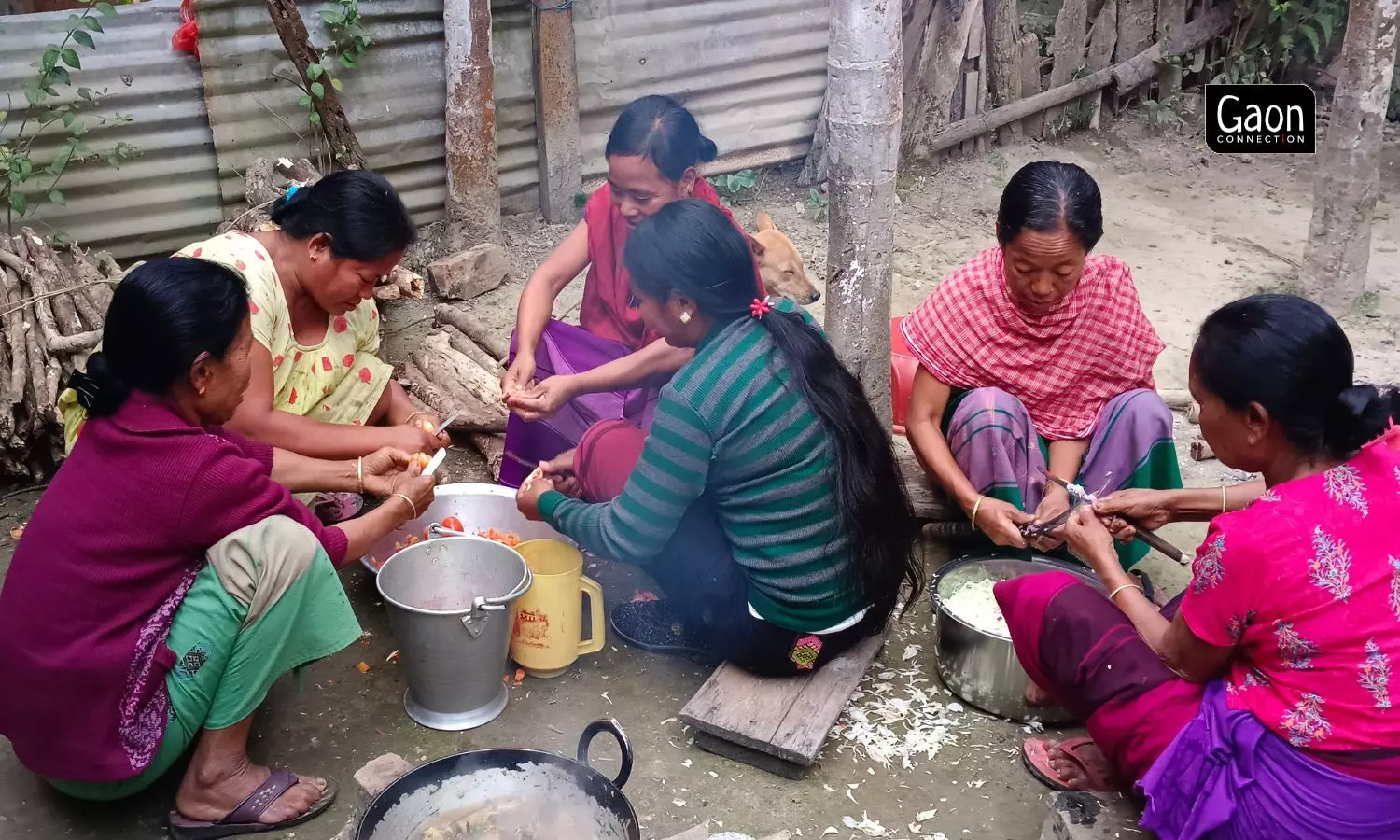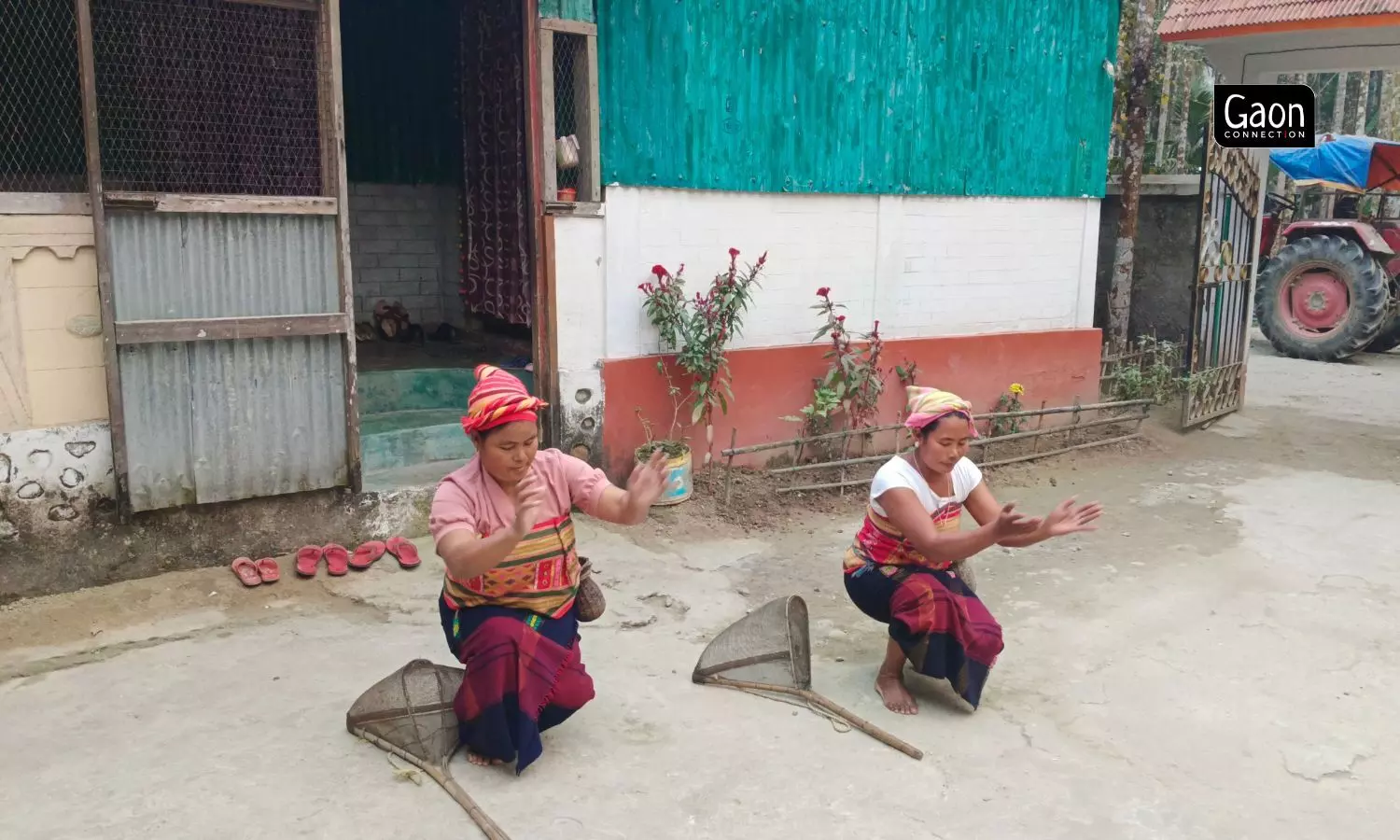Uttar Mendabari (Alipurduar district), West Bengal
In his village flanked by beautiful hills and mustard fields, Dhanbir Rabha sat holding a bamboo flute as his grandchildren played around and a strong flavour of tea wafted through his mud courtyard in the winter afternoon.
He is the last one left.
In his Uttar Mendabari Village in the Alipurduar district of West Bengal not far from Bhutan, 68-year-old Rabha is the last remaining musician of the Rabha community who can play the traditional khal. The khal is a tribal bamboo flute that signifies celebration and pain, and traditionally been essential to weddings, festivities and funerals.
“The younger generation is not interested in learning to play the khal,” Rabha told Gaon Connection. “It has been part of our culture since ages but I am the only Rabha who knows how to play it.”
The village, located a few kilometres from the highway, is surrounded by hills and mustard fields currently draped in yellow flowers, in an area frequented by elephants. Rabha has a mud-and-thatch hut in which the women in the family sat sipping tea as his grandchildren played around. A fire burnt in the courtyard in the cold winter afternoon.

Uttar Mendabari village is in the Alipurduar district of West Bengal not far from Bhutan, nestled in a forested area.
There are 172 families of the Rabha community living in Uttar Mendabari village, about 700 kilometres north of Kolkata, the state capital.
The Rabha community loves its music and almost every occasion is celebrated with song and dance. “The farkranti dance is performed during funerals. The hamjhar dance and song is associated with agriculture, and the sathar dance is like the Bihu of Assam. The young people perform it when they are choosing their life partners,” Swapni, a 48-year-old inhabitant of Uttar Mendabari, told Gaon Connection.
Apart from celebration, the khal is also used in expressing pain.
The plaintive notes from the khal usually accompany funeral rites of the Rabhas, a vulnerable tribal community that is spread across Assam, Meghalaya, and West Bengal.

“The burials take place usually during the day. So all night the mourners keep vigil as we believe unholy spirits might enter the body if it is left alone during the night. And, that is when the khal is played, to help them stay awake,” Dhanbir Rabha, a khal player, told Gaon Connection.
It is believed that Rabhas were originally from Tibet. They moved towards the Garo hills in Meghalaya before spreading across the Assam lowlands. Some of them later settled in North Bengal.
Also Read: Rajasthan Kabir Yatra 2022: A perfect jugalbandi of music, people, philosophy and nature
Also, the special kind of bamboo used to craft the khal is found only deep in the forests and is fast dwindling. It is a favourite food for elephants, he added.
But there is also an effort from the tribe to hold on to their customs.
Phoolmati Rabha has taken it upon herself to teach younger people in the community the traditional folk songs and dances. “We have a rich culture of song and dance for every occasion but most of the young women do not know them. Dance moves from movies are becoming more popular,” the 30-year-old, told Gaon Connection. It is leading to a loss of Rabha culture and identity, Phoolmati lamented.

Geetmala Rabha acknowledged the fact. “We should have learnt our folk songs which are part of our culture. But, we have realised our mistake and are trying to learn and nurture our identity. It might vanish if we do not do that,” the 27-year-old from the village, told Gaon Connection.
Another reason for losing touch with many of the traditional rituals could be that most of the Rabhas have converted to Christianity, say the local villagers.
Also Read: Virtual Bharat: Recreating the Muthuvan marriage
History and livelihood of Rabhas
The Rabhas are agrarian, but do not have rights over their land. “We have been farming here for several generations but are yet to get our rights. While the Forest Rights Act allows us to have land holdings in our name, it is not done yet. We have no rights over our land and it is yet to be converted to a revenue village. Besides, we also suffer from elephant attacks that destroy our fields and damage our crops,” said 45-year-old Kutin Rabha, a farmer, complained.
The Rabhas have a rich tradition of art and craft and weave their own attire on handlooms. The women weave and wear a wrap-around skirt called Koum Kontong with beautiful motifs and wrap a long cloth across their upper bodies known as Kambag.

The Rabha community loves its music and almost every occasion is celebrated with song and dance.
“We conducted a weaving workshop in Uttar Mendabari village and are planning to promote their art and music through programmes in Kolkata and other parts of the state,” Biplab Choudhuri, coordinator of Banglanatok.com, a social enterprise, told Gaon Connection. “We are also trying to encourage the younger generation to learn the khal from Dhanbir as he is the only surviving artisan in their clan who knows it,” he added.
According to Choudhuri, work to promote the art and craft of the Rabhas began last year under the Rural Craft and Cultural Hubs of West Bengal that has been jointly promoted by the state Ministry of Micro, Small & Medium Enterprises. and UNESCO.


















